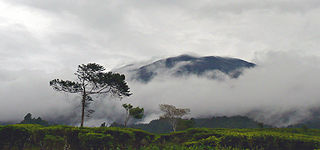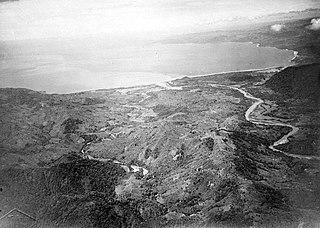
Mount Tambora, or Tomboro, is an active stratovolcano in West Nusa Tenggara, Indonesia. Located on Sumbawa in the Lesser Sunda Islands, it was formed by the active subduction zones beneath it. Before 1815, its elevation reached more than 4,300 metres high, making it one of the tallest peaks in the Indonesian archipelago.

The Indonesian island of Java is almost entirely of volcanic origin, and contains numerous volcanoes, 45 of which are considered active volcanoes. As is the case for many other Indonesian islands, volcanoes have played a vital role in the geological and human history of Java. Indeed, land is created on Java as a result of lava flows, ash deposits, and mud flows (lahars). Volcanoes are a major contributor to the immense fertility of Java, as natural erosion transports volcanic material as alluvium to the island's plains, forming thick layers of fertile sediment. The benefit is not just in the immediate vicinity of the volcano, with fine ash emitted from eruptions being dispersed over wide areas.

Mount Merapi,, is an active stratovolcano located on the border between the province of Central Java and the Special Region of Yogyakarta, Indonesia. It is the most active volcano in Indonesia and has erupted regularly since 1548. It is located approximately 28 km (17 mi) north of Yogyakarta city which has a population of 2.4 million, and thousands of people live on the flanks of the volcano, with villages as high as 1,700 m (5,577 ft) above sea level.

The Kelud is an mountain stratovolcano located in Kediri, East Java, Indonesia. Like many Indonesian volcanoes and others on the Pacific Ring of Fire, Kelud is known for large explosive eruptions throughout its history. More than 30 eruptions have occurred since 1000 AD. In 2007, an effusive explosion filled the crater with a lava dome. It last erupted on 13 February 2014, destroying the lava dome and ejecting boulders, stones and ashes up to West Java about 500 kilometres (310 mi) from Mount Kelud. The crater filled with water during the rainy season.

Ci Liwung is a 119 km long river in the northwestern region of Java where it flows through two provinces, West Java and the special region of Jakarta. The natural estuary of the Ciliwung river, known as the Kali Besar, was an important strategic point for trade in the precolonial and colonial periods and was instrumental in the founding of the port city of Jakarta, but has been lost from reorganization of the watercourse of the rivers around the area into canals.

Mount Merbabu is a dormant stratovolcano in Central Java province on the Indonesian island of Java. The name Merbabu could be loosely translated as 'Mountain of Ash' from the Javanese combined words; Meru means "mountain" and awu or abu means "ash".

Mount Gede or Gunung Gede is a stratovolcano in West Java, Indonesia. The volcano contains two peaks with Mount Gede as one peak and Mount Pangrango for the other one. Three major cities, Cianjur, Sukabumi and Bogor, are located in the volcano complex at the east, south and northwest, respectively, along with suburban growth. Seven craters are located in the complex: Baru, Gumuruh (2,927 m), Lanang (2,800 m), Kawah Leutik, Ratu (2,800 m), Sela (2,709 m) and Wadon (2,600 m). Historical volcanic activity has been recorded since the 16th century. With the amalgamation and growth of Greater Jakarta with those 3 cities, dense suburban growth has engulfed the fringes of the volcano, home to roughly 4 million people. Though not listed as one of the Decade Volcanoes or thought to produce large eruptions, the huge populations nearby give a potential for severe destruction if indeed a large eruption did occur.

Mount Papandayan is a complex stratovolcano, located in Garut Regency, to the southeast of the city of Bandung in West Java, Indonesia. It is about 15 kilometres (9.3 mi) to the southwest of the town of Garut. At the summit, there are four large craters which contain active fumarole fields. An eruption in 1772 caused the northeast flank to collapse producing a catastrophic debris avalanche that destroyed 40 villages and killed nearly 3,000 people. The eruption truncated the volcano into a broad shape with two peaks and a flat area 1.1 km wide with Alun-Alun crater in the middle, making the mountain appear as a twin volcano; one of the peaks is called Papandayan and the other Mount Puntang.

Mount Gede Pangrango National Park is a national park in West Java, Indonesia. The park is centred on two volcanoes—Mount Gede and Mount Pangrango—and is 150 km² in area.

Mount Pangrango is a dormant stratovolcano located in the Sunda Arc of West Java, Indonesia. The mountain formed by a subduction zone on the southern coast of Java as part of the Sunda Plate facing the Australian Plate which contains Indian Ocean. It is located about 80 kilometres (50 mi) south of Jakarta, the capital of Indonesia.

Mandiri River is a river in southwestern Java of West Java province, Indonesia. It flows mainly in the Sukabumi Regency.

Kawah Putih is a crater lake and tourist spot in a volcanic crater about 50 kilometres (31 mi) south of Bandung in West Java in Indonesia.

Lake Bandung was a prehistoric lake located in and around the city of Bandung, Parahyangan highlands, West Java, Indonesia. believed to exist between 126,000 and 20,000 BCE in the Pleitocene due to the violent eruption of Mount Sunda that blocked the Citarum River, causing the lowlands to begin to be inundated with water, eventually forming a lake.
Mount Sunda, was an ancient volcano that once stood in Priangan highlands in today's West Java province, Java island, Indonesia. The Sunda volcano existed during Pleistocene age, before a violent Plinian eruption caused its summit to collapse. The volcano formed the northern ridge of the Bandung Basin. The ancient volcano is the predecessor of today's Tangkuban Perahu, Burangrang, and Bukit Tunggul volcanoes.

Mount Halimun is a mountain in the island of Java, Indonesia. It is protected by the Mount Halimun Salak National Park. It is Banten's highest point.

Blue lava, also known as Api Biru, and simply referred to as blue fire or sulfur fire, is a phenomenon that occurs when sulfur burns. It is an electric-blue flame that has the illusory appearance of lava. Despite the name, the phenomenon is actually a sulfuric fire that resembles the appearance of lava, rather than actual lava from a volcanic eruption. The most well-documented of these fires occur on Indonesia's Kawah Ijen volcano, where they regularly burn.

The Cianten is a river which flows in the western part of Bogor Regency, West Java, and is a tributary of the Cisadane River.


















